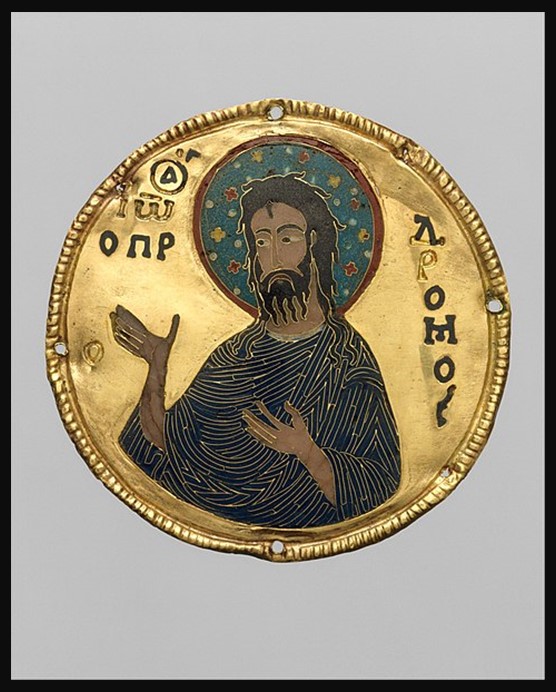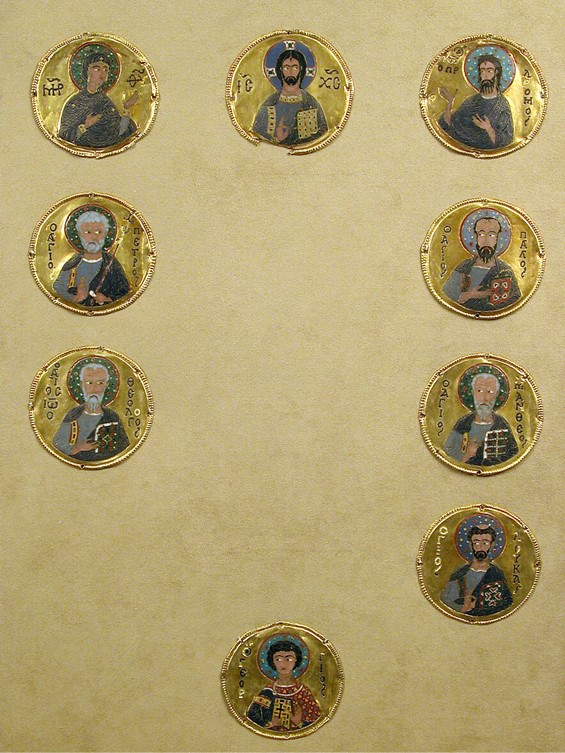
https://www.metmuseum.org/art/collection/search/464550
On the 7th of January, the Feast Day of Saint John the Baptist, the Greek Orthodox Church celebrates a significant figure in the Christian tradition. His Apolytikio is a testimony to his elevated status… The memory of the just is celebrated with hymns of praise, but the Lord’s testimony is sufficient for thee, O Forerunner; for thou hast proved to be truly even more venerable than the Prophets, since thou was granted to baptize in the running waters Him Whom they proclaimed. The Gold Medallion of Saint John the Forerunner in the MET is evidence of his importance in the arts. https://www.oramaworld.com/en/p/210255/Saint_John_the_Baptist_-_Aged_Byzantine_Icon
Saint John the Forerunner holds a prominent place in Christian iconography, his imagery rich with symbolic significance. The Icon of John baptizing Jesus in the Jordan River is a powerful representation of his pivotal role in preparing the way for the Savior. The lamb, a common element in depictions of John, symbolizes Christ as the “Lamb of God” who takes away the sins of the world. This type of artwork not only emphasizes John’s humility in recognizing Christ’s divine nature but also underscores the transformative nature of baptism. In Christian art, Saint John the Baptist serves as a bridge between the Old and New Testaments, symbolizing the transition from the era of prophets to the advent of the Messiah. His portrayal in religious art continues to inspire contemplation on themes of repentance, humility, and the heralding of spiritual renewal.
Today’s BLOG POST presents a MET treasure, a small Gold Medallion with Saint John the Forerunner in the Cloisonné technique, a traditional practice in art and metalwork, often associated with Byzantine art.
The MET Medallion of Saint John, along with eight more, was part of the decoration of a precious Frame for an Icon dedicated to the Archangel Gabriel, possibly a gift from the Byzantine court to the neighboring Christian state of Georgia. These types of medallions are valued not only for their aesthetic beauty but also for their historical and cultural significance, offering insights into the artistic achievements of the Byzantine Empire. https://www.metmuseum.org/art/collection/search/464550

The Precious Frames of Icons serve to underscore the icon’s significance, imparting both aesthetic appeal and worldly value to its religious status. Positioned at the upper narrow side of the frame, MET experts have identified three Roundels featuring Christ at the center. He is unmistakably distinguished by His cross-nimbus, extending a blessing with His right hand while cradling a Gospel book in His left. Flanking Him are the Medallions of the Mother of God (recognized by the Orthodox abbreviation ‘ΜΗΤΗΡ ΘΕΟΥ’) to His right and that of John the Forerunner (the standard Orthodox title for John the Baptist) to His left. These three figures, adopting a posture of intercession, collectively constitute the ‘Deesis,’ a term translating to ‘prayer’ or ‘supplication’ in Greek. For Byzantine iconography, ‘Deesis’ scenes, portray Christ as the divine judge and mediator between humanity and God, with Mary and John serving as the most effective intercessors for humankind alongside Christ. In essence, the ‘Deesis’ scene stands as a potent visual representation of the Byzantine Christian understanding of divine mercy, intercession, and the final judgment, positioning Christ at the epicenter of authority and mediation.
The remaining MET Medallions on the discussed Icon Frame depict the hierarchical arrangement of the Church. Positioned just beneath the ‘Deesis’ scene are the Apostles Saints Peter and Paul. Below the Medallion of Saint Paul, one finds the two Evangelists, Saints Matthew and Luke. Saint John the Theologian is situated beneath Saint Peter, and at the bottom narrow side of the Frame, we encounter the depiction of the military Saint, George.
For a Student Activity inspired by the Gold Medallion of Saint John the Forerunner in the MET, please… Check HERE!
Cloisonné is a decorative technique that involves the use of enamel, gemstones, or glass to fill compartments (cloisons) created by metal wires or strips on a metal surface. The word “cloisonné” comes from the French word for compartment. This technique was widely used in the Byzantine Empire, particularly in creating intricate designs on metal objects like jewelry, religious artifacts, and decorative items. The spaces, or cloisons, are filled with colorful enamel, creating a vibrant and detailed surface.